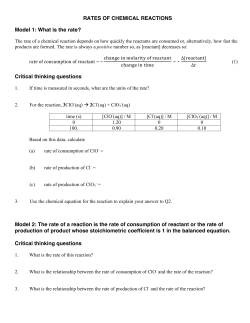
CP Chapter 12 Stoichiometry amounts
CP Chapter 12 Stoichiometry What is Stoichiometry? ( STOY-KEE-AHM-EH-TREE) Stoichiometry is the part of chemistry that studies amounts of reactants and products that are involved in reactions. Chemists use a ___________________ chemical __________________ as a basis to calculate how much reactant is _____________ or product is _____________ in a reaction. A balanced chemical equation can be interpreted in terms of different quantities, including number of ____________, ____________, or ______________. In a balanced chemical equation, the ________________________ in an equation represents not only numbers of individual _________________ but also numbers of ______________. The basis for stoichiometry is the law of conservation of mass, which states the mass of the reactants will ____________________ the mass of the products. What Do the Coefficients Mean? Balance the equation. ____N2 + ____H2 ____NH3 This equation can be looked at with ________ molecule of N2 reacts with __________ molecules of H2 to produce two ________________ of NH3. Or This equation can be looked at as one mole of N2 reacts with three ____________ of H2 to produce _________ moles of NH3. Mole Ratio A mole ratio is a _______________ factor derived from the ______________ of a balanced chemical equation interpreted in terms of ______________. Balance the equation and write all six mole ratios. ____Fe + ____O2 ____Fe2O3 Balance the equation and write all six mole ratios. ____Al + ____Br2 ____AlBr3 1 Mole to Mole How many moles of CO2 will be produced by the complete reaction of 2.00 mol of glucose (C6H12O6)? ____C6H12O6 + ____O2 ____CO2 + ____H2O How many moles of ammonia (NH3) can be produced from 8.50 mol of hydrogen reacting with nitrogen? ____H2(g) + ____N2(g) ____NH3(g) How many moles of aluminum are needed to form 4.73 mol of Al2O3? ____Al(s) + ____O2(g) ____Al2O3(s) 2 Mole to Mass What mass of hydrogen can be produced by reacting 6.000 mol of Al with HCl? ____Al + ____HCl ____AlCl3 + ____H2 What mass of AlCl3 can be produced by the reaction of 4.00 mol of HCl with Al? Mass to Mole How many moles of water can be produced by burning 325 g of octane (C8H18)? ____C8H18 + ____O2 > ____CO2 + ____H2O How many moles of CO2 can be produced by using up 145 g of oxygen? 3 Mass to Mass What mass of carbon dioxide is produced by the complete combustion of 100.0 g of pentane (C5H12)? ____C5H12 + ____O2 ____CO2 + ____H2O How many grams of HNO3 are required to produce 8.75 g of dinitrogen monoxide (N2O) according to the following equation? ____Zn + ____HNO3 ____Zn(NO3)2 + ____N2O + ____H2O How many grams of NH3 are produced by the reaction of 5.40 g of hydrogen with excess nitrogen? ____N2(g) + ____H2(g) ____NH3(g) 4 Limiting Reactant (Limiting Reagent) Limiting reactant or reagent - The ______________ that is totally used up during the chemical reaction, ______________ the amount of ____________ produced. Excess reactant or reagent – The _____________ present in a quantity that is ___________than what is needed to react with the __________________ reactant. The excess reactant ___________ after the limiting reactant has been used up. Note: The limiting reactant is not necessarily the substance that has the lower amount of reactant. The limiting reactant is the one that will produce the least amount of product. What is the limiting reactant? ___________________________________________ What are the excess reactants?__________________________________________ 5 How many grams of silver bromide (AgBr) can be formed when solutions containing 50.0 g of MgBr 2 and 100.0g of AgNO3 are mixed together? What is the limiting reactant? What is in excess? What is the mass of the excess reactant that remains after the reaction is complete? ____MgBr2 + ____AgNO3 ____AgBr + ____Mg(NO3)2 How many grams of hydrogen chloride can be produced from 1.00 g of hydrogen and 55.0 g of chlorine? What is the limiting reactant? What is in excess? What is the mass of the excess reactant that remains after the reaction is complete? ____H2 + ____Cl2 ____HCl 6 How many grams of barium sulfate (BaSO4) will be formed from 200.0 g of barium nitrate (Ba(NO3)2) and 150.0 g of sodium sulfate (Na2SO4)? What is the limiting reactant? What is in excess? What is the mass of the excess reactant that remains after the reaction is complete? ____Ba(NO3)2 + ____Na2SO4 ____BaSO4 + ____NaNO3 Percent Yield Theoretical yield is the __________________________ amount of product that can be produced from a given amount of __________________________. Theoretical yield is calculated using stoichiometry. Actual yield is the amount of product actually produced when the chemical reaction is carried out in an _________________________. Percent yield is a comparison of the actual and percent yield. In general, the higher the percent yield, the better the results are for the experiment. Percent Yield = _______________________________________ 7 Determine the theoretical yield of Ag2CrO4 if 0.500 g of AgNO3 is used to react with K2CrO4. Also, if 0.455 g of Ag2CrO4 is obtained from an experiment, calculate the percent yield. ____AgNO3(aq) + ____K2CrO4(aq) ____Ag2CrO4(s) + ____KNO3(aq) CCl4 was prepared by reacting 100.0 g of CS2 and 100.0 g Cl2. Calculate the theoretical yield and percent yield if 65.0 g of CCl4 was obtained from the reaction. ____CS2 + ____Cl2 ____CCl4 + ____S2Cl2 8 Silver bromide (AgBr) was prepared by reacting 200.0g of magnesium bromide and 100.0 g of silver nitrate. Calculate the theoretical and percent yield if 100.0 g of silver bromide was obtained from the reaction ____MgBr2 +____AgNO3 ____Mg(NO3)2 + ____AgBr 9
© Copyright 2025





















